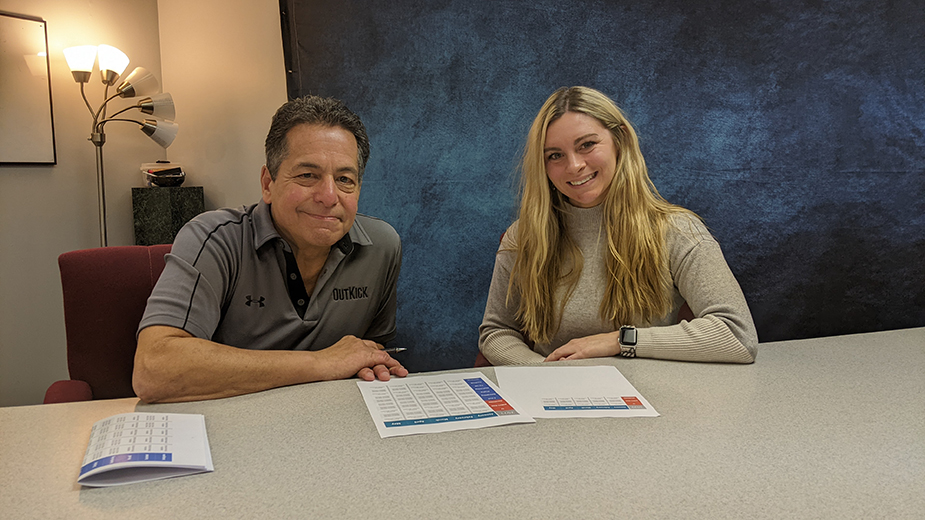YOUNGSTOWN, Ohio – It’s safe to assume most people don’t log onto Facebook or YouTube for the ads.
Yet, the money companies and marketing agencies put toward digital marketing, including social ad campaigns, steadily increases.
In November 2021, Facebook ad revenues in the United States were closing in on $50.3 billion, a year-over-year increase of 32.1%, reports eMarketer. This year, the market research company projects that number to increase to $58.11 billion.
With Facebook and Instagram maintaining their heavyweight status and new contenders like TikTok staking their claims, how can small businesses cut through the noise and get their content seen?
The Business Journal sat down with representatives from area marketing agencies to identify some digital marketing best practices.
Those interviewed include George Farris and Makenna Ozenghar, Farris Marketing; Jon Elias, Palo Creative; Mandy Stoffel, Advantage Video & Marketing Solutions; and Tony Marr and Adrienne Sabo; Clever agency.
Six or seven years ago, Farris, CEO of the agency that bears his name, likely wouldn’t have recommended a client scale back on TV, direct mail and billboards to invest in digital, he says. Times have changed, however, and today a blend of traditional and digital media produces a better response.
“I would feel comfortable cutting the traditional media in half and spending the rest of it on various digital media,” Farris says. “The technology has improved and the targeting has improved. It’s almost insane not to reallocate funds from traditional media to digital now.”
Email newsletters, retargeting, display ads, geofencing, YouTube pre-roll and social media are all contenders in a digital marketing plan, Farris says. The goal is to have an integrated campaign with traditional and digital media “that reaches people with the right message at the right time and hits the right market,” he says.
Farris and Ozenghar, vice president of client service, says this could be a tough sell for clients that are heavy users of traditional media.
But as more consumers value convenience, they are engaging mobile devices as much as they are TV ads.
“Where do you want to be? Do you want to be where you used to be and kind of in the ear of the customer?” Ozenghar says. “Or do you want to be in the sightline of the customer and at the click of their fingertips?”
The challenge for marketing agencies, they say, is to identify the right platforms for clients and craft the most effective messaging.
Ozenghar advises clients to take a “less is more approach” and be efficient on specific platforms “where your target audiences are at,” she says.
“If you’re just on there and you’re not making it effective for who you’re trying to serve, that’s not helping you,” she says. “People are going on there [but] you’re not keeping your services and products up to date.”
Integrate and Maintain Your Message
Whichever solutions companies opt for, marketing professionals agree they must be integrated across the board.

Websites, social media and Google My Business directory listings must be aligned with one brand voice. Otherwise the message will be disjointed and companies won’t have “the most advantageous results from your digital marketing campaigns,” says Stoffel, creative and marketing director for Advantage Video.
When it comes to search rankings – how close your company is to the top of the list – search engines like Google consider the quality of search ads as well as the quality of the page they link to and its content, she says.
“Is it credible? Does it have authority? Is it relevant?” Stoffel says. “Is this something that makes Google look great if we send them to the results?”
Building credibility and authenticity with content will return the kind of results a client wants in a digital ad campaign, she says.
That starts with creating compelling content.
Stoffel recommends using that content in as many ways as possible. A testimonial video on a website can be repurposed into a LinkedIn post. Then a 15-second snippet can be shared with a Facebook story or an Instagram reel, she says.
“Video is everything in terms of results and in terms of really taking advantage of the algorithms on all the platforms,” she says. “We can create a ton of content from it.”
No matter the solution, Stoffel advises clients to have patience. It may take a few attempts to start getting a sizable response.
“At the same time that you’re learning about your audience and who’s responding,” she says, “the algorithms and the platforms are learning about you as well. So, the more consistent you are and the more you establish a strategy and have a partnership with someone who’s working on that with you, the more effective your campaigns will be.”
When crafting content, Clever’s Sabo, business development director, recommends writing as if to answer a question. More often, users are searching for questions or phrases rather than keywords, particularly as more users opt for talk-to-text searches instead of keying things in.
As Google has “gotten smarter” over time, searches place more value on useful, well-written content that is constantly being added, Sabo says.

“If you’re doing a site about marketing, if you put in, ‘What is digital marketing?’ then you answer that question yourself, Google will be like, ‘Oh you have answers,’” she says. “So, you will rank a little bit higher. It’s sort of in the way you phrase things.”
Clever’s Marr, creative director, recommends keeping the copy conversational while still including keywords. And at the end of the day, “design still matters,” he says.
“You see it all over the place where people just put out a website and it’s just word sausage … and it has just really bad stock images,” Marr says. “A lot of the time, that’s going to keep people from buying your product or using your services.”
Rather than use generic stock images, Marr suggests companies take professional photos of individuals actively using their product or service, which will encourage other prospects to try it.
Facebook and TikTok and Reddit, Oh My!
Long-standing social platforms like Facebook, LinkedIn, Twitter and Instagram are still going strong. But companies and marketing agencies are leveraging other platforms with thousands of sub-platforms and communities within them to access a more targeted audience.
“You can go on Reddit and there’s a fantasy football community with 50,000 people,” says Elias, marketing strategy director for Palo Creative. “They may be on Reddit. But most of their time is spent in that subreddit.”
Interacting with subgroups on LinkedIn and Reddit also helps small businesses identify their customers’ pain points, he says. Information gathered in comment threads helps businesses put together more focused marketing plans.
Elias offers this example: If a company is trying to target managers of manufacturing facilities with a solution, the company is more likely to have success in a LinkedIn group for facility managers than a general Facebook campaign.

“I think one of the things that doesn’t get talked about enough is targeting users based on intent,” he says. “What we want to map out is how we’re going to get customers in various stages of the buyer’s journey down the funnel.”
Attracting prospects at the top of the sales funnel might be about identifying pain points and creating content to help them identify and understand those issues and not so much asking them to buy a product, Elias says.
For instance, he cites an e-book on how to reduce downtime targeted to manufacturers.
Downloading and reading the e-book creates an engagement with the company, pushing the prospect further down the funnel, according to Elias.
It also provides the company with first-person data that it can put into its customer relationship management, or a CRM system, to target those individuals with ads for solutions.
“You can put them on a workflow, and those workflows should be intended to drive them down the funnel to the point where they’re ready to talk to a salesperson, to have a demo or make a purchase,” he says.
Solutions can include retargeting ads that are a bit more product-focused. Search ads with a “buy now” call-to-action would be for the bottom of the funnel and drive users to a product or e-commerce page, Elias says.
“There has to be structure and there has to be a thought process of timing,” he says.
Elias advises companies to keep the messaging simple because overly produced ads can be overlooked while prospects are scrolling.
Even if the message, targeted persona and timing are perfect, if the design is “too much” or doesn’t get the point across quickly enough, “it doesn’t matter,” Elias says.
“We’re dealing in micro-moments,” he says. “When you’re scrolling down a feed, you may only have a split second to grab someone’s attention.”
Pictured at top: George Farris and Makenna Ozenghar, Farris Marketing.
